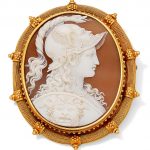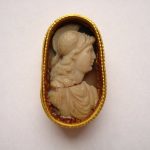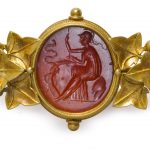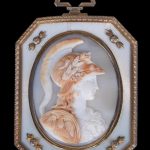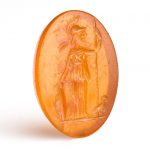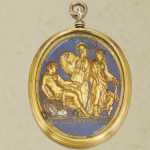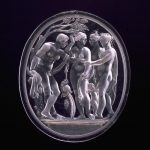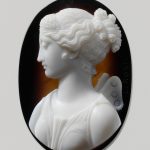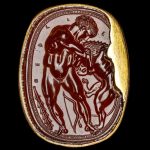Minerva was the Roman goddess of wisdom and strategic warfare and the sponsor of arts, trade, and strategy. The Romans did not stress her relation to battle and warfare as the Greeks did. From the second century BC onward, the Romans equated her with the Greek goddess Athena. Reference: Wikipedia.
Cameo; onyx; helmeted bust of Minerva to right; stone has been broken across below the neck. Collet setting, still with cardboard collar.
© The Trustees of the British Museum
A ROMAN CARNELIAN RINGSTONE WITH MINERVA CIRCA 1ST-2ND CENTURY A.D. Mounted as a pin in a 19th century gold setting ⅜ in. (1 cm.) wide
Sold for USD 4,000 at Christies in 2016
Minerva receiving Holy Roman Emperor Francis II (1768–1835) (r. 1792–1804), afterwards Emperor Francis I of Austria, (r. 1804–35) Manufacturer: Josiah Wedgwood and Sons (1759–present) Designer: John Flaxman (British, York 1755–1826 London) ca. 1792
Reference: The Metropolitan Museum of Art
Gem with Minerva Roman Imperial Period 1st–2nd century
Orange carnelian. Oval intaglio with flat front and beveled edges. Minerva, wearing a peplos and crested helmet, with spear and shield, standing frontally with head turned to right. At her feet at right, an owl. Partial groundline.
Reference: Museum of Fine Arts Boston
Valerio Belli (c. 1468-1546) Italian, Rome, early 16th century INTAGLIO OF MARS, MINERVA, VENUS AND CUPID gilt rock crystal, lapis lazuli, mounted in gold pendant 60 by 43mm., 2 3/8 by 1 5/8 in.
The male figure with a bare breast and a helmet next to his right foot may be Mars or an unidentified young warrior. Opposite him the two goddesses Minerva (shown in full armour) and Venus with her son Cupid represent two antithetical forces, between which Mars has to make his choice: Wisdom and responsibility on one side, lust and pleasure on the other. The goddesses’ opposition is expressed by their heads turned into profiles against each other. The fact that Minerva stands closer to Mars and that a snake (symbol of wisdom) glides over his hand and twists around the armrest indicates which goddess will get the better of the other. Mars is shown with his eyes closed, according to the popular iconographical scheme of Hercules at the crossroads, of which this subject is a learned variation. This composition was particularly appealing to Renaissance humanists, as it was repeated on a number of bronze plaquettes (examples in Basel, Historisches Museum; Brescia, Musei Civici; London, British Museum; Milan, Castello Sforzesco; Paris, Cabinet des Médailles; Vicenza, Museo Civico).
Sold for 61,250 GBP at Sotheby’s in 2008
The Judgement of Paris Intaglio
Reference: © Victoria and Albert Museum
Date: ca. 1520-1530 (made) Artist/Maker: Belli, Valerio, born 1468 – died 1546 (maker)Oval plaque. On the left, leaning against a tree trunk is Paris – nude, his shield, sword and helmet on the ground – he bends forward to pass an apple to Venus, who is depicted on the far right of the composition – also nude, with a cloak wrapped around her neck hanging down her back. At her feet is a little Cupid, winged, and reaching up to her. In the centre is Minerva, and behind her Juno.
